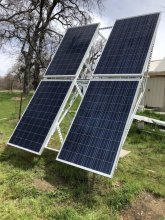Wesleydeb
New Member
- Joined
- Dec 5, 2020
- Messages
- 14
I series stringed 4 12 volt 100 watt renogy PV panels into my 12 KW Growatt Off Grid inverter charging a Flooded Golf Cart Battery Bank.... Battery Bank is 8 x 6 volt Golf cart batteries that I recovered from a broken down Golf cart.. I purchased the batteries new thinking it would fix the old golf cart but found out the chassis was broken so I put them in the Solar System when I built it..
My question is; the contractor I purchased the Inverter from tells me that series stringing 4 renogy panels is not enough to full utilize the MPPT feature in the Inverter Charger... They recommend series stringing 6 panels...
Does anyone have any thoughts on this... Will Prowse this would make a good video for you to discuss benefits or cons to series stringing multiple panels and whether 4 each 12 volt panels in series is enough for a 48volt solar charger???
Thanks for any information regarding this.
My question is; the contractor I purchased the Inverter from tells me that series stringing 4 renogy panels is not enough to full utilize the MPPT feature in the Inverter Charger... They recommend series stringing 6 panels...
Does anyone have any thoughts on this... Will Prowse this would make a good video for you to discuss benefits or cons to series stringing multiple panels and whether 4 each 12 volt panels in series is enough for a 48volt solar charger???
Thanks for any information regarding this.






